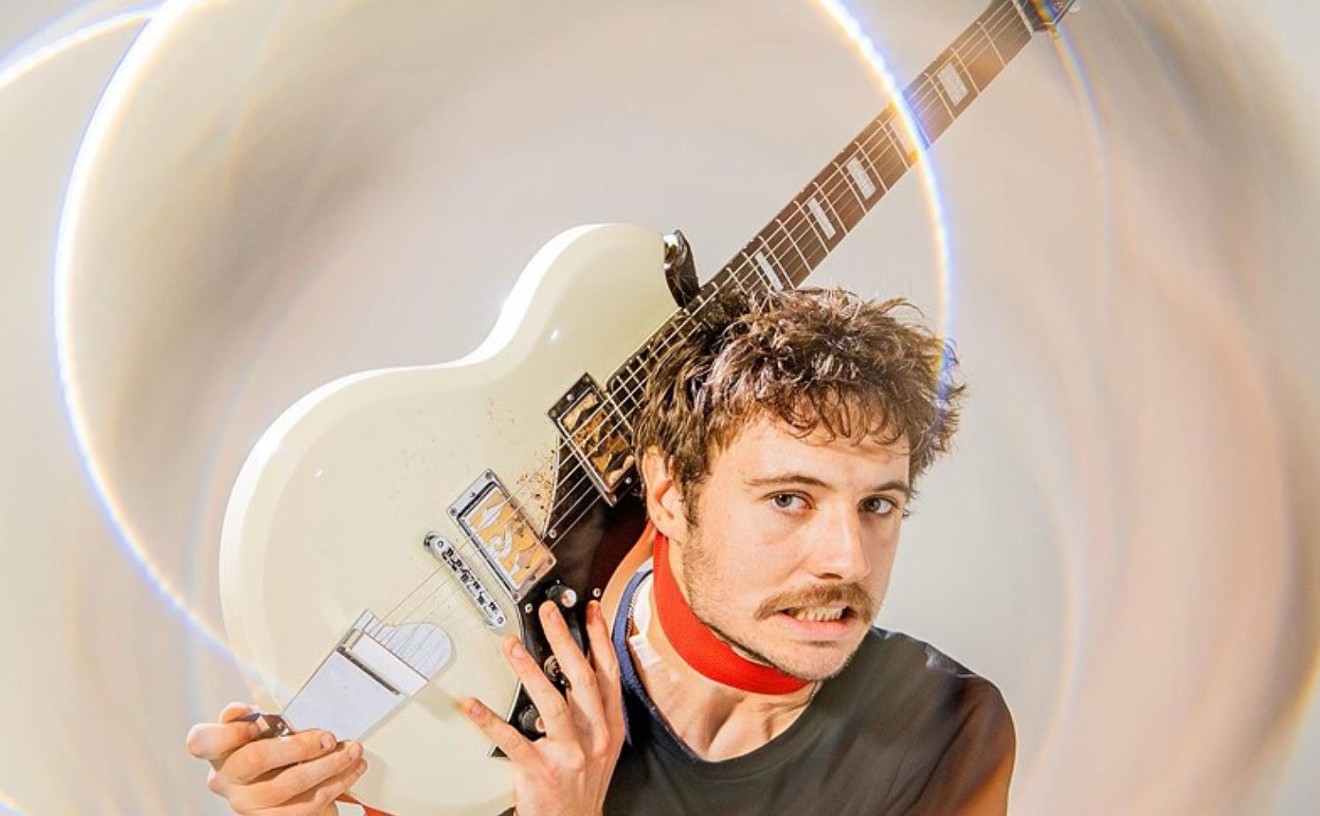Here at the edge of the desert, a small miracle is taking place.
Thirteen miles from the Utah border, an abandoned Rio Grande water tank sits on a small hill two blocks north of the main drag of Rangely. Made of welded, half-inch-thick steel plates, the tank is sixty feet tall and thirty feet in diameter. It doesn’t look like much from the outside, but inside it’s a deeply resonant, reverberant space — by a fluke, an acoustic chamber unlike any other in existence. Called the Tank, it’s sustained by an unlikely coalition of locals and musicians from around the world.
Back in 1976, Denver musician and sound artist Bruce Odland was part of a state-sponsored traveling arts program; Rangely was one of the stops. Odland was walking around town with his microphones and recorders, gathering sounds to create a collage for playback to the town that evening when two oil workers stopped him. “A four-by-four, a big rig, pulls up and said, ‘Are you the guy?,’” Odland remembers. “I said yes, they said, ‘Get in,’ and I said, ‘Okay.’ We drove away into the dirt hills of Colorado...and there was this immense, hulking, silver steel Jules-Verne-trip-to-the-moon capsule sitting in a dirt crater. Gray dirt, silver capsule.”
An eighteen-inch portal, low to the ground, was the only access point. The men told Odland to climb inside and turn on his recording equipment, then started whanging on the outside with two-by-fours. “The reverb from that event goes on to this day,” Odland says. “It’s extraordinary. There’s really nothing like it.”
The Tank, which was assembled at its present site in the mid-’60s, had primarily served as a hangout for teens and partiers before Odland was introduced to it. “I believe it was utilized as part of an ongoing effort to upset the previous generation,” Odland says. Because of engineering concerns, it had never held water: It was set in unstable, pebbly soil. This happenstance may have endowed the Tank with its unique properties.
“It’s a reverse parabolic dish on the bottom,” explains Mark McCoin, a former Denver musician who now teaches at the University of Texas at San Antonio. “The sound goes straight up, like a convection oven. It has its own resonant frequency, which changes with the temperature and relative humidity. It generates its own overtones, and there’s a sustain like nowhere else.”
McCoin was part of a small group of musicians and sound engineers — Ron Miles, Brian Waters, Lois LaFond, Bob Drake, Michael Stanwood, Mark Fuller, Elton Norwood and others — whom Odland took on regular pilgrimages to the site. The pilgrims experimented wildly with the Tank. Given the lack of both amenities and permission, they snuck in at night, sleeping in and around the structure — and borrowing power via a 200-foot extension cord from a friendly neighbor across the way. During the 1980s, Odland and his friends collected material there for three extraordinary albums whose contents range from slashing sheets of electronic sound and rhythmic frenzy to delicate, meditative, acoustic trances. The music circulated, and sound artists from around the world began to play at the Tank, generating more recordings until the structure gained avant-garde-celebrity status. Over 35 years, more than seventy musicians made unauthorized use of the Tank, including two-time Grammy winner Tom Wassinger.
But in 1999, worried about liability, the property’s owner, Jude Hacking, sealed the access hatch. Suddenly shut out of the chamber, the musicians started talking with Hacking about the possibility of acquiring the property. For a grand total of $10, Hacking wound up selling the Tank and five of its nine surrounding acres to Stanwood, who maintained it for a dozen years with the help of the informal Order of the Tank. But in 2012, an offer came to buy the Tank and sell it for scrap. Stanwood, who felt he had reached the end of his stewardship, turned to the artist who’d first discovered the Tank.
What followed was an extraordinary outreach effort. The musicians and their supporters organized as Friends of the Tank, and in 2013 they went before the Rangely City Council to pitch their idea to save the structure. “We were about as far apart philosophically from these folks as you could possibly be,” remembers Boulder musician LaFond. An initially skeptical, conservative crowd was won over by the sincerity of the Friends, their promise to consult the town and incorporate its desires into the effort — and their attention to detail. A long conversation between the town’s mayor and LaFond’s husband, civil-rights lawyer Dick LaFond, proved pivotal to the deal.
An oil-and-gas-industry town on the edge of the high desert, Rangely has always been prone to economic slides. “We decided we were polar opposites,” says Dick, “but we found out we both wanted to help the town.” The Friends turned Rangely’s residents into stakeholders.
An ambitious plan to bring the site up to code and expand its scope was created, and a nonprofit corporation was formed. The Friends launched a $12,000 Kickstarter campaign, which soon garnered more than $46,000. With some funding assured, debris and extraneous piping were removed from the Tank. Local volunteers joined in, bulldozing a new access road and setting up electrical power, sanitary facilities, proper ventilation, and lighting and safety features that brought the site into compliance with state and local regulations. After two years of effort, a use permit and a certificate of occupancy were issued. The Tank was in business.
A human-sized door was even created — fortunately, without damaging the Tank’s sound. Lois LaFond cut it open with an acetylene torch. As she recalls: “We were there, and the welder was like, ‘Have you ever cut a door before?’ I was like, ‘No?’ And he was like, ‘Well, you are now!’”
A shipping container was converted into a recording studio and placed next to the Tank on a bed of pulped Crocs, of all things. “You want to have as little vibration as possible,” explains Odland. “We went to the landfill, and there were these incredibly colorful mounds of crushed-up Crocs. We loaded them into erosion-resistant bags and put the studio on that.” Odland doesn’t mention — but everyone else does — how he scrambled underneath the multi-ton appendage dangling from a crane during installation, making sure the bed was placed correctly. He was also fond of clambering up onto the roof of the Tank to work on it.
“That’s Bruce,” says LaFond. “He just kind of does his thing.”
A new Kickstarter campaign will launch in February, to raise funds to purchase permanent recording equipment for the studio. In order for the project to thrive, it must be self-sustaining and hard-wired into the life of the region. “In some ways, the community is way ahead of us on this,” says Odland.
The Colorado Northwestern Community College and the local K-12 school district have begun holding educational programs at the Tank. The Flobots visited in September, as part of the Colorado Creative Industries Detour cultural-outreach program. There can be residencies, research, concerts, music festivals and installations at what is now being called the Center for the Sonic Arts.
Build it, and they will come.
Singer Elaine Urie runs a trucking company in Rangely; intensely spiritual, she’s an ardent Friend of the Tank, one of the “keepers of the keys” for the now-secured location. On what will turn into a hot morning, she brings a jacket on a visit to the structure. “It takes a while for it to heat up in the daylight,” she explains.
We step through the door, a heavy slab that wouldn’t look out of place on Captain Nemo’s Nautilus. The space inside is open, save for some instruments and supplies around the perimeter. The walls are painted russet, embossed with the names of more than 800 Tank supporters in silver script.
My questions trail off and we stand in silence. There is a palpable ambience in here, something awe-inspiring and otherworldly, but warm and comforting, too. Urie leans her head back.
“Oh, hallelujah,” she sings. “Oh, hallelujah....” The sound flies up, grows, fractures into harmonics and descends, enveloping us with vibration, a net of cascading cadence that lands on the skin. It penetrates, profoundly moving.
“You have to sing to it,” offers Urie, echoing statements that others have made about the space.
“You don’t play an instrument in the Tank,” says Odland. “You play the Tank with your instrument.”
“It imposes its own sense of what’s right,” adds McCoin. “You go in there with an idea of what you want to do, and then the Tank bends your sound to its own parameters.”
“This whole thing has been about us and them getting out of our little boxes, our specific ways of thinking,” Urie continues. “We did, and we met in the middle, and look what we have!”
She and many others in Rangely are looking forward to learning and performing in the Tank and sharing it with the outside world. Odland will be back, but he considers his creative time here to be largely over. Now he just wants to make sure that others can discover its delights as well.
“We were just the sonic pilgrims,” he says. “We improvised our way through all these hurdles. It took years to make this all legal and safe for people to use. Now we want to make it so that it can run itself. We want to see what the new people will do with it.”
For more information about the Tank, visit tanksounds.org.
[
{
"name": "Air - MediumRectangle - Inline Content - Mobile Display Size",
"component": "12017618",
"insertPoint": "2",
"requiredCountToDisplay": "2"
},{
"name": "Editor Picks",
"component": "17242653",
"insertPoint": "4",
"requiredCountToDisplay": "1"
},{
"name": "Inline Links",
"component": "18838239",
"insertPoint": "8th",
"startingPoint": 8,
"requiredCountToDisplay": "7",
"maxInsertions": 25
},{
"name": "Air - MediumRectangle - Combo - Inline Content",
"component": "17261320",
"insertPoint": "8th",
"startingPoint": 8,
"requiredCountToDisplay": "7",
"maxInsertions": 25
},{
"name": "Inline Links",
"component": "18838239",
"insertPoint": "8th",
"startingPoint": 12,
"requiredCountToDisplay": "11",
"maxInsertions": 25
},{
"name": "Air - Leaderboard Tower - Combo - Inline Content",
"component": "17261321",
"insertPoint": "8th",
"startingPoint": 12,
"requiredCountToDisplay": "11",
"maxInsertions": 25
}
]











